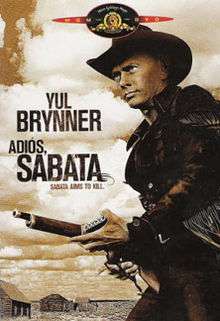Adiós, Sabata
| Adiós, Sabata (Indio Black, sai che ti dico: Sei un gran figlio di...) | |
|---|---|
 The DVD cover | |
| Directed by | Frank Kramer |
| Produced by | Alberto Grimaldi |
| Screenplay by |
Renato Izzo Gianfranco Parolini |
| Starring |
Yul Brynner Dean Reed Pedro Sanchez Joseph P. Persaud Susan Scott Gianni Rizzo |
| Music by | Bruno Nicolai |
| Cinematography | Sandro Mancori |
| Edited by | Gianfranco Parolini (uncredited) |
Production company | |
| Distributed by |
PEA (Italy) United Artists (US) |
Release date |
|
Running time | 104 minutes |
| Country | Italy |
| Language | Italian |
Adiós, Sabata (Italian: Indio Black, sai che ti dico: Sei un gran figlio di..., roughly translated as Indio Black, you know what I'm going to tell you ... You're a big son of a ....) is a 1970 Italian Spaghetti Western film directed by Gianfranco Parolini. It is the second film in The Sabata Trilogy by Parolini. Yul Brynner takes over the lead role from Lee Van Cleef, who stars in the first and third films.[1]
The film was originally going to be entitled Indio Black, but the title was changed after the first Sabata film proved successful and had inspired many imitators. Van Cleef had been offered the starring role in the film, but had to decline because he was committed to The Magnificent Seven Ride in the role of Chris Adams, which Brynner had made famous in The Magnificent Seven.
Plot
Set in Mexico under the rule of Emperor Maximilian I, Sabata is hired by the guerrilla leader Señor Ocaño to steal a wagonload of gold from the Austrian army. However, when Sabata and his partners Escudo and Ballantine obtain the wagon, they find it is not full of gold but of sand, and that the gold was taken by Austrian Colonel Skimmel. So Sabata plans to steal back the gold.
Sabata's rifle
Sabata carries a sawed off lever action rifle with a side-loading magazine containing seven .30/30 Remington rimfire cartridges...and one cigar. Guns based on a horizontal loading slide magazine were called harmonica guns (the magazine resembling a harmonica). There is no record of a lever action harmonica magazine rifle, so this gun was almost certainly a prop creation. Harmonica guns generally required a cocking action plus a manual advancement of the magazine, hence the lever action in this gun to cock it and the visible position of Brynner's hand to advance the magazine to the next cartridge position.
Cast
- Yul Brynner as Sabata/Indio Black
- Dean Reed as Ballantine
- Ignazio Spalla as Escudo
- Gérard Herter as Colonel Skimmel
- Sal Borgese as Septiembre
- Franco Fantasia as Señor Ocaño
- Joseph P. Persaud as Gitano
- Andrea Scotti as José
- Gianni Rizzo as Folgen
- Salvatore Billa as Manuel
- Massimo Carocci as Juan de los Angeles
- Omar Bonaro as Jesus
- Luciano Casamonica as Juanito
- Vittorio Fanfoni as barman
- Bruno Corazzari as Hertz
- Vitti Caronia as 1st Lieutenant Stejar
- Franco Marletta as Mexican
- Lina Franchi Mexican woman
- Antonio Gradoli Major Matternich
- Giuseppe Castellano as Thomas Kerr as Graduato
- Federico Boido as Rick Boyd as Geroll
- Giovanni Siragusa as Johnny Nation as Perdido
- Andrea Aurelli as Adjutant Ocaño
- Calisto Calisti as Chief Eagle Pass
- Thomas Rudy as Cortejo
- Furio Pellerani as Garcia
- Stefano Rizzo as Mexican revolutionary
- Nieves Navarro (Susan Scott) as saloon singer
- Giovanni Cianfriglia as Ken Wood as Austrian agent
- Angel Alvarez as bounty hunter agency manager
- Furio Meniconi as Murdock
- José Galera Balazote as runt
- Elio Angelucci as bearded villager
- José Canalejas as duel observer
- Fortunato Arena as duel observer
Bibliography
- Hughes, Howard (2010). Spaghetti Westerns. Harpenden: Kamera Books. ISBN 978-1-84243-303-4.
References
- ↑ Hughes, p.113